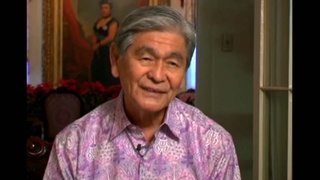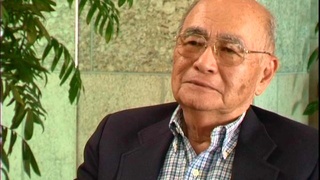Interviews
Training for football by carrying 100-lb bags of grass over mountains
When I was a ninth grade, I went to Lahainaluna. Where I was staying, I couldn't get transportation because it's six miles to Lahaina, and there's no transportation for me to go to school. So, I asked the coach that I could be a boarder and stay at the dormitory at Lahainaluna. So, they told me that they have room for me. So, I stayed at Lahainaluna two years, the freshman and sophomore year.
And my job there was every morning, I have to go and pick a hundred pound of grass to feed the cows because they had a farm there where they raise cows and pigs and chicken, ducks and lot of vegetables and things. See, they had about 125 boarders there, so they had to feed them and things. And a lot of times, the milk and lot of the eggs and things, they sell it -- go downtown and they sell it. So, that was my job. I'd get up 5 o'clock in the morning, my freshman, sophomore year, and I would go pick 100 pound. Sometimes I had to climb two mountains and 100 pounds on my back coming in. But, that really helped me in football because that really strengthened my legs.
Date: December 16, 2003
Location: Hawai'i, US
Interviewer: Art Hansen, John Esaki
Contributed by: Watase Media Arts Center, Japanese American National Museum.
Explore More Videos

Teacher who helped with lisp
(b.1926) Democratic politician and three-term Governor of Hawai'i

Little interaction with parents
(1926 - 2012) Scholar and professor of anthropology. Leader in the establishment of ethnic studies as an academic discipline

Politics in ethnic studies
(1926 - 2012) Scholar and professor of anthropology. Leader in the establishment of ethnic studies as an academic discipline

Center for Japanese American Studies in community
(1926 - 2012) Scholar and professor of anthropology. Leader in the establishment of ethnic studies as an academic discipline

Involvement with ethnic studies
(1926 - 2012) Scholar and professor of anthropology. Leader in the establishment of ethnic studies as an academic discipline

Testing assumptions of Japanese scholars
(1926 - 2012) Scholar and professor of anthropology. Leader in the establishment of ethnic studies as an academic discipline

Sings traditional plantation labor song (ho-le ho-le bushi) in Japanese and Hawaiian
(b.1900) Issei plantation worker in Hawai'i.

Kids working hard
An expert researcher and scholar on Japanese immigrant clothing.

First day of school
An expert researcher and scholar on Japanese immigrant clothing.

Grandmother's influence on decision to go to Japan
(b.1942) Japanese American ceramist, who has lived in Japan for over 30 years.

Teaching at the military language school during World War II
(b. 1924) Political scientist, educator, and administrator from Hawai`i

Lesson learned from community college faculty
(b. 1924) Political scientist, educator, and administrator from Hawai`i

Rewards of teaching
(b. 1924) Political scientist, educator, and administrator from Hawai`i

Japanese school
(b.1924) Japanese Canadian Nisei. Interpreter for British Army in Japan after WWII. Active in Japanese Canadian community

Sugar-beets farm in Alberta
(b.1924) Japanese Canadian Nisei. Interpreter for British Army in Japan after WWII. Active in Japanese Canadian community
